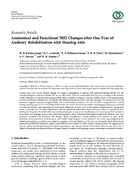Use este identificador para citar ou linkar para este item:
https://repositorio.ufrn.br/handle/123456789/25920| Título: | Anatomical and functional MRI changes after one year of auditory rehabilitation with hearing aids |
| Autor(es): | Pereira-Jorge, M. R. Andrade, K. C. Palhano-Fontes, F. X. Diniz, P. R. B. Sturzbecher, M. Santos, A. C. Araújo, Dráulio Barros de |
| Palavras-chave: | hearing aids;peripheral hearing deficits;auditory rehabilitation |
| Data do documento: | 10-Set-2018 |
| Referência: | PEREIRA-JORGE, M. R et al. Anatomical and functional MRI changes after one year of auditory rehabilitation with hearing aids. Neural Plasticity, v. 2018, n. 9303674, p. 13, set./2018. |
| Resumo: | Hearing aids (HAs) are an effective strategy for auditory rehabilitation in patients with peripheral hearing deficits. Yet, the neurophysiological mechanisms behind HA use are still unclear. Thus far, most studies have focused on changes in the auditory system, although it is expected that hearing deficits affect a number of cognitive systems, notably speech. In the present study, we used audiometric evaluations in 14 patients with bilateral hearing loss before and after one year of continuous HA use and functional magnetic resonance imaging (fMRI) and cortical thickness analysis in 12 and 10 of them compared with a normal hearing control group. Prior to HA fitting, fMRI activity was found reduced in the auditory and language systems and increased in visual and frontal areas, expanding to multimodal integration cortices, such as the superior temporal gyrus, intraparietal sulcus, and insula. One year after rehabilitation with HA, significant audiometric improvement was observed, especially in free-field Speech Reception Threshold (SRT) test and functional gain, a measure of HA efficiency. HA use increased fMRI activity in the auditory and language cortices and multimodal integration areas. Individual fMRI signal changes from all these areas were positively correlated with individual SRT changes. Before rehabilitation, cortical thickness was increased in parts of the prefrontal cortex, precuneus, fusiform gyrus, and middle temporal gyrus. It was reduced in the insula, supramarginal gyrus, medial temporal gyrus, occipital cortex, posterior cingulate cortex, and claustrum. After HA use, increased cortical thickness was observed in multimodal integration regions, particularly the very caudal end of the superior temporal sulcus, the angular gyrus, and the inferior parietal gyrus/superior temporal gyrus/insula. Our data provide the first evidence that one year of HA use is related to functional and anatomical brain changes, notably in auditory and language systems, extending to multimodal cortices. |
| URI: | https://repositorio.ufrn.br/jspui/handle/123456789/25920 |
| Aparece nas coleções: | ICe - Artigos publicados em periódicos |
Arquivos associados a este item:
| Arquivo | Descrição | Tamanho | Formato | |
|---|---|---|---|---|
| DraulioAraujo_ICe_2018_Anatomical and functional.pdf | DraulioAraujo_ICe_2018_Anatomical and functional | 3,65 MB | Adobe PDF |  Visualizar/Abrir |
Os itens no repositório estão protegidos por copyright, com todos os direitos reservados, salvo quando é indicado o contrário.

